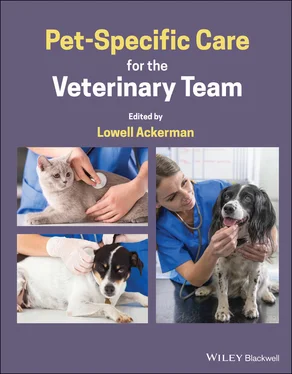Abbreviation
HABHuman–animal bond
1 1 American Veterinary Medical Association. (2019). Human–Animal Bond (Policy/Position Statement). www.avma.org/resources‐tools/avma‐policies/human‐animal‐interaction‐and‐human‐animal‐bond
2 2 Patronek, G.J., Glickman, L.T., Beck, A.M. et al. (1996). Risk factors for relinquishment of dogs to an animal shelter. Journal of the American Veterinary Medical Association 209 (3): 572–581.
3 3 Dreschel, N.A. (2010). The effects of fear and anxiety on health and lifespan in pet dogs. Applied Animal Behaviour Science 125: 157–162.
4 4 Stella, J., Croney, C., and Buffington, T. (2013). Effects of stressors on the behavior and physiology of domestic cats. Applied Animal Behaviour Science 143: 157–163.
5 5 Blackwell, E., Twells, C., Seawright, A., and Casey, R. (2008). The relationship between training methods and the occurrence of behavior problems, as reported by owners, in a population of domestic dogs. Journal of Veterinary Behavior 3 (5): 207–217.
6 6 Ziv, G. (2017). The effects of using aversive training methods in dogs – a review. Journal of Veterinary Behavior 19: 50–60.
7 7 Sampedro‐Piquero, P. and Begega, A. (2017). Environmental enrichment as a positive behavioral intervention across the lifespan. Current Neuropharmacology 15 (4): 459–470.
1 Brooks, D., Churchill, J., Fein, K. et al. (2014). 2014 AAHA weight management guidelines for dogs and cats. Journal of the American Animal Hospital Association 50: 1–11.
2 Knesl, O., Hart, B.L., Fine, A.H., and Cooper, L. (2016). Opportunities for incorporating the human‐animal bond in companion animal practice. Journal of the American Veterinary Medical Association 249 (1): 42–44.
3 Todd, Z. (2017). New Literature Review Recommends Reward‐Based Training. www.companionanimalpsychology.com/2017/04/new‐literature‐review‐recommends‐reward.html
4 Todd, Z. (2016) Seven Reasons to Use Reward‐Based Dog Training. www.companionanimalpsychology.com/2016/06/seven‐reasons‐to‐use‐reward‐based‐dog.html
2.16 Pain and Pain Management
Mark E. Epstein, DVM, DABVP (Canine/Feline), CVPP
TotalBond Veterinary Hospitals, PC, Gastonia, NC, USA
 BASICS
BASICS
It may come as a disappointing surprise to some that the focus on recognition, assessment, prevention, and management of pain in dogs and cats is a relatively recent phenomenon, having gained significant traction only since the late 1990s.
Furthermore, underrecognition and undermanagement of pain is not merely an ethical problem – although it is very much that – but generates significant physiological and medical consequences leading to increased patient morbidity at the very least (protracted patient recovery, compromised quality of life), and at times possibly even mortality (including humane euthanasia).
The very good news is that pain management is now a central, and increasingly sophisticated, feature of small animal medicine and surgery, with an increasingly wide array of tools at the disposal of all members of the veterinary team.
Allodynia:A pain response to nonnoxious stimuli such as touch and light pressure.
Dysthesia:Unpleasant or abnormal sensation, e.g., tingling, burning, itching, numbness.
Hyperalgesia:An exaggerated pain response to a noxious stimulus.
Hypersensitization:The molecular and cellular “wind‐up” in peripheral tissue and dorsal horn of the spinal cord, characterized by decreased neuron firing threshold, decreased descending inhibition, recruitment of bystanding neurons and more; results in maladaptive pain.
Nociception:Pain processing with peripheral neuronal activation, transmission in the primary afferent neuron, modulation in the spinal cord, and perception in various centers throughout the brain.
Osteoarthritis ( OA ):A subset of degenerative joint disease that occurs when the protecting cartilage on the ends of bones wears down over time.
Pain:Multidimensional unpleasant sensory and emotional experience associated with actual or potential tissue damage. Chronic pain occurs when the pain persists for three months or longer.
Pain, Adaptive:Normal and protective pain.
Pain, Acute:Pain experienced during the expected time of posttrauma inflammation and healing.
Pain, Chronic:Pain experienced past the expected time of posttrauma inflammation and healing (in humans, defined as pain still present 2–3 months or longer after initial tissue damage).
Pain, Maladaptive:Peripheral and central hypersensitization‐induced abnormal pain, characterized by increased scope, character, and field of pain: hyperalgesia, allodynia, dysthesias.
Pain, Neuropathic:Hypersensitization and maladaptive pain that has progressed to gene expression and permanent morphological and functional changes in the peripheral and central nervous system (CNS); pain as a disease at this point.
 MAIN CONCEPTS
MAIN CONCEPTS
Pain (defined by the International Association for the Study of Pain, IASP) is an unpleasant sensory and emotional experience associated with actual or potential tissue damage [1]. Pain is not merely the sensation or perception of it, but has an additional affective, emotional component. In other words, pain is said to be multidimensional (i.e., it is not just what you feel, but how it makes you feel ). This is because pain pathways terminate not only in the frontal cortex (perception), but in deep, primitive parts of the brain (the limbic center) that control emotions such as anger, fear, anxiety, stress, even depression. And with this “stress response” comes a release of hormones such as cortisol, epinephrine, and proinflammatory cytokines; these very molecules actually then sensitize nociceptors, the specialized neurons that carry pain signals. In other words, a circular problem can be present: pain causes stress, and stress causes pain.
Chronic pain, furthermore, has been shown to elicit harmful cognitive changes: decreased learning, memory, and other features of mental acuity and agility; in humans it is also co‐morbid with clinical depression (and one must wonder if this element does not also exist in dogs and cats).
Nociception involves several neurons. The “first‐order” neuron transducts tissue damage (mechanical, thermal, chemical, etc.) into a signal that is transmitted via action potential up to the dorsal horn of the spinal cord (the largest cells in the body; its nucleus is in the dorsal root ganglion). There in the dorsal horn, excitatory neurotransmitters are released and carry the signal across a synapse to the “second‐order” neuron which then depolarizes and carries an action potential to the brain. The body has intrinsic ways of mitigating pain, through inhibitory neurons that reside in the dorsal horn and those that descend from the brain down to the dorsal horn. It is in the dorsal horn where pain signaling can be modulated; that is, like a rheostat, it can be dialed up or down – either by the body itself or through veterinary interventions.
Читать дальше

 BASICS
BASICS MAIN CONCEPTS
MAIN CONCEPTS










